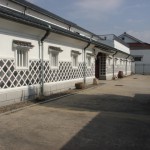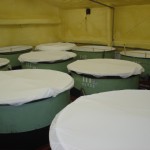I have trouble finding one definition of terroir that more than a couple of people agree with. After scouring the bodies of wine knowledge out there (read: I poked around the internet for an hour) the ones that rang the most true were along the lines of “characteristics that are region or even parcel-of-land specific” or even more simply a “sense of somewhere,” or something that ties a wine to a very specific place. In other words, for any one or more of a myriad of reasons, the wine could not be exactly reproduced anywhere else.
After scouring the bodies of wine knowledge out there (read: I poked around the internet for an hour) the ones that rang the most true were along the lines of “characteristics that are region or even parcel-of-land specific” or even more simply a “sense of somewhere,” or something that ties a wine to a very specific place. In other words, for any one or more of a myriad of reasons, the wine could not be exactly reproduced anywhere else.
The question of whether or not sake has terroir comes up with increasing frequency, with the main – and very valid – argument that it might not have true terroir stemming from the fact that the rice used in brewing can be brought in from regions far from the kura (brewery) itself. Heck, brewers from around the country brag about using Yamada Nishiki from Hyogo, even when they are half a country away from Hyogo. That’s a huge chink in the armor of any terroir or regionality argument.
There are those that say it is in the water. The argument goes that since the water cannot be moved, and since the water is tied to a parcel of land, then it is the water itself that defines the terroir of sake. And since sake is like 80 percent water in the end, the leverage is huge.
But, in fact, water can indeed be brought in from a distance, and while not commonly done, it does happen. Furthermore, any parcel of land can have half a dozen water sources and types, depending on where and how deep the well is dug. Also, the water in any one place is really sourced in mountains far away, and it drifts underground for leagues upon leagues before arriving at one spot, and as such there are many places along the way with very similar sources of water. So while the water-is-sake’s-terroir argument is not totally unfounded, I cannot buy into it fully myself.
So, then, does sake have that sense of can-only-be-done-here and cannot-be-reproduced-anywhere known as terroir? And if so, from whence does it hail?
I espouse that it does, and that said terroir is found in none other than the kura itself.
Yes, the kura is but a brewery building. At least on the surface. But integrated into that are the design elements of the toji, or the kuramoto (the brewery owner or business decision maker), and perhaps not even that of the present generation. But the layout/design they have, be it new or 400 years old, is what it is, and is unique in countless ways.
We need to expound on that a bit further, but also bear in mind that in my larger definition of kura here, I include the intention and personality of the toji and his or her supporting cast. Just how that crew works within the physical environment that constitutes the kura will be unique to that time and place, and be impossible to reproduce anywhere else.
We also need to include the nature of the kuramoto as well. Is the owner one who is willing to buy the best rice, in advance, and pay top yen to secure it, or instead string out the toji by pulling strings in the background to get decent rice at better prices. Both are valid approaches! And both will contribute to aspects of a kura that cannot be reproduced elsewhere, especially after having been factored into the overall permutation of things happening at a particular kura.
Also, when the kuramoto and the toji are the same person, or at least the same family, then one dynamic is eliminated. Or another becomes evident – depending on your viewpoint. (Half-full or half-empty?) As this is now the case for about a fourth of the industry, it is indeed a significant aspect of any conversation on sake terroir.
But back to the physical structure of the kura itself. To me, this is where a mark of indelible character is impressed upon what is brewed here. There are countless little things, the aggregate of which makes a given sake simply impossible to recreate anywhere else.
The task of trying to convey this is so daunting I shudder at the thought of where to begin. Let us start with size.
How big is the kura; what is its capacity? How many tanks? How big are the batches? Are they same size for cheap sake as they are for daiginjo? Do they have enough to start a tank a day, or just three a week, or perhaps only one a week? Do they have enough people to watch all of that closely or do they automate? What about temperature control? Is the kura in a cold or warm region? How thick are the walls?
Do they mill in house? How do they wash and soak their rice? How big is the koji room, f’gad’s sake? This is huge. Just how much they can make at one time, and what the attention to detail can be are massively leveraging.
Even little things like how far the koji room is from where they steam their rice is an issue. What about the foyer outside the koji room where they cool it down before adding it to a batch? How does that affect cooling and drying out the koji? Big, big, big in terms of effects on the sake!
What about the yeast starter room? Big or small, refrigerated or not, tightly sealed off or more open? And what of the layout of the fermentation tanks? How do they press the sake? Do they have more than one apparatus that lets the sake tell them when to press it, or do they need to coax the sake to be ready so as to keep on a schedule? How do they do that pressing – with a new machine or an older, traditional one?
more open? And what of the layout of the fermentation tanks? How do they press the sake? Do they have more than one apparatus that lets the sake tell them when to press it, or do they need to coax the sake to be ready so as to keep on a schedule? How do they do that pressing – with a new machine or an older, traditional one?
Note, none of these factors is unequivocally better than another. All are just different. All contribute to the final terroir of the sake made there.
How do they pasteurize as a rule? How do they store? Distance, pipes, pumps, filters – all of these things have their say in the end.
Then there is the unexplainable. Some yeasts work better in some kura than others. No one knows why. It just is that way. One tank might make consistently better sake than another, by virtue of what no one really knows.
It’s in the kura
Remember that all this is before we even throw in the sake-making techniques themselves, or the skill and intention of the toji (brew master). What rice do they use, what yeast, how far do they mill, how good is their sanitation? What technical methods do they use for the yeast starter – normal, yamahai, kimoto or some variation unique to them?
This list could go on, and for a long time. But where it all leads is to the fact that in any one given kura, there will be a unique set of countless conditions that ensure that the sake made there cannot be reproduced anywhere else.
And therein lies the terroir of sake.
So yes, sake does indeed have terroir – a sense of place, a set of circumstances that ties a given sake to a single place, and it essentially cannot be reproduced anywhere else. And it’s in the kura.
Check out my latest book Sake Confidential: http://www.cbsdsmarttools.com/sites/m98110/index.html




